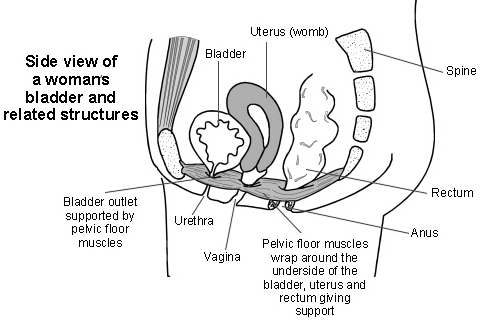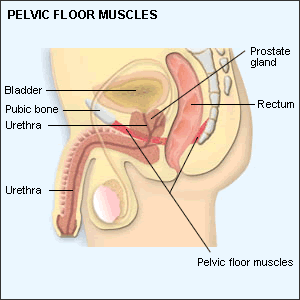The pelvic floor are muscles that extend from the pubic bone at the front of the pelvis to the tail bone at the back and act as a sling to support the pelvic organs. It also controls the openings of the pelvic organs. In both sexes it acts to prevent incontinence and also plays a part in sexual function.
Childbirth isn’t the only reason that the pelvic floor can become weak. Other reasons include:
- A lack of exercise
- Menopause
- After surgery on the pelvis or abdomen
- Straining on the toilet
- Being overweight
- Chronic cough
- Increased risk with smoking
- Arterial disease
If the pelvic floor is weak then you can develop stress incontinence. This is when urine leakage occurs when doing things that cause a sudden rise in abdominal pressure such as cough, sneezing, running or jumping.
In women other symptoms include an increased need to visit the toilet or increased urgency to get to the toilet that can result in leaking before you get there. There can also be reduced ability to control the passing of wind. It might feel like there is aching or dragging in vagina or that something is coming down, which can be a symptom of the pelvic organs descending from their normal position.

But it’s not just women who are affected by a weak pelvic floor. Men take heed…!
Recent research suggests that pelvic floor exercises are as effective as Viagra in the treatment of erectile dysfunction. The exercises work by strengthening the muscles around the penis and improving blood supply in the pelvis. In this study, around 40% of the men who worked at strengthening their pelvic floor muscles for three months regained full sexual function - a further 30% had improved function. It also suggests that the exercises can help with premature ejaculation and with ‘dribbling’ after urinating. And it can improve the quality of orgasm!

Even if you are not having symptoms, prevention is better than cure and it’s never too late to start. Convinced? Here’s how it’s done…
Pelvic Floor Exercises
Once you can feel your pelvic floor muscles working, you can attempt to exercise them. People often think that they are doing the exercises well when they are not… It is always a good idea to come in to the clinic for an appointment with a specialist to check that your technique is correct. If you are experiencing symptoms then you will certainly benefit greatly from individual assessment and treatment.
In general, to find your pelvic floor muscles, you should sit or lie comfortably with the muscles of your thighs, bottom and stomach relaxed.
The muscles of the pelvic floor need both endurance and strength training if they are to function properly.
For good endurance, tighten and draw in the muscles around the anus and urethra, lifting the muscles up inside. Count to ten, then release and relax. Repeat 8-10 squeezes, resting for 10 seconds between each repetition.
For fast, strong contractions which kick in to protect you against leaking when you sneeze for instance, you should also practice getting a fast, maximal contraction without the hold.
Repeat the slow and quick squeezes around four to five times a day.
And keep going! It can take months to notice improvements and once you do, it is important to keep going or you will slip back again. Like brushing your teeth, doing your pelvic floor exercises should be a lifelong habit.
Remember also that if you have symptoms or difficulty doing the exercises, or if the exercises aren’t working then it is important to see your GP or women’s/ men’s health therapist who will be able to help.
Good luck!!
Our Barnes Clinic
Our clinic is located in Barnes, South-West London and is easily accessible by public transport.
For more information including parking and other practicalities see our Barnes clinic page
Book an Appointment
Booking an appointment with one of our therapists is quick and easy. There is no long waiting time and you don’t need a referral from your GP.








